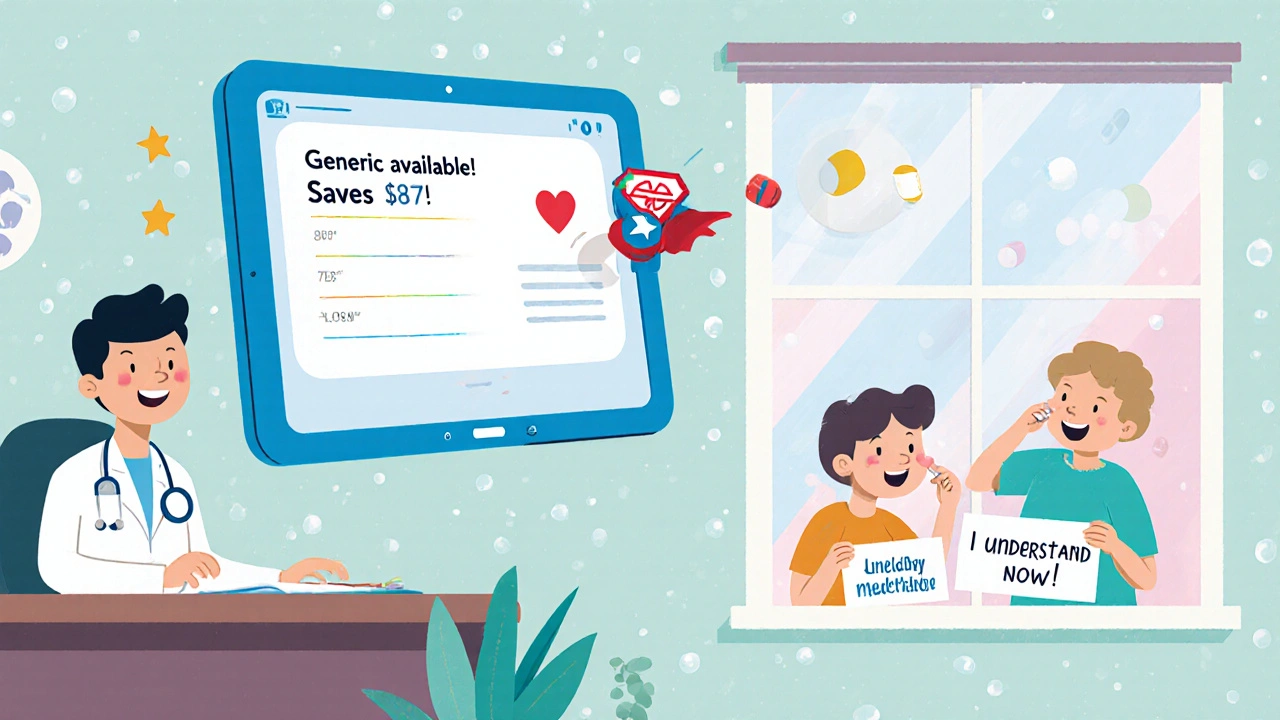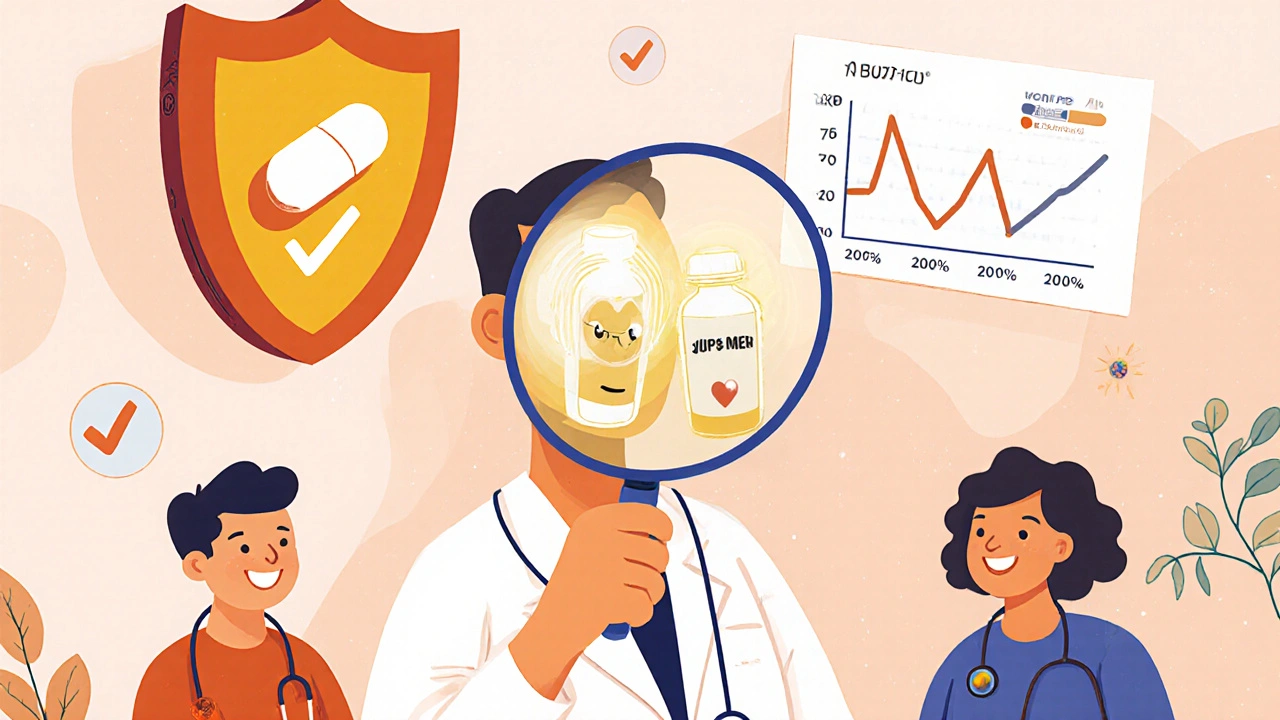Doctors prescribe generics more than 90% of the time in the U.S., but how many actually understand generic equivalence? The answer isn’t what you’d expect. Even though generic drugs save the healthcare system billions and are approved by the FDA as safe and effective, many physicians still harbor doubts. Why? Because medical schools rarely teach them how to think about generics the right way.
What Generic Equivalence Really Means
When the FDA approves a generic drug, it doesn’t just say, "This looks similar." It demands proof. The generic must deliver the same active ingredient at the same rate and amount as the brand-name drug. That’s called bioequivalence. The standard? The body’s absorption of the drug - measured by AUC and Cmax - must fall within 80% to 125% of the brand’s levels. That’s not a guess. It’s science. And it applies to every drug class, whether it’s blood pressure pills, antibiotics, or even drugs for epilepsy.
But here’s the problem: most doctors never learned this in medical school. A 2024 Medscape poll found that only 31% of physicians regularly use International Nonproprietary Names (INN) when prescribing - meaning they write "metformin" instead of "Glucophage." The rest default to brand names, even when generics are available. Why? Because their training was built on brand names. Case studies, textbooks, and lectures used brand names. Generics were an afterthought.
The Education Gap
A single pharmacology course might spend 12 hours on how brand-name drugs work, but less than 30 minutes on generics. That’s not an accident. It’s a systemic blind spot. In Malaysia, a 2015 study found that 100% of doctors had major misconceptions about generics before any training. After a 45-minute lecture on bioequivalence, their knowledge jumped by 25%. But their prescribing habits? Still the same.
Knowledge doesn’t automatically change behavior. Doctors don’t just need facts - they need context. They need to see how generics fit into real patient care. One neurologist in a 2022 survey admitted he avoids switching epilepsy patients to generics because he’s seen "cases where patients seemed to lose control." But the FDA says the bioequivalence standards for antiepileptics are no different than for any other drug. So what’s really happening? Often, it’s not the drug. It’s the patient’s anxiety. Or a change in inactive ingredients causing minor stomach upset. Or a pharmacist switching brands without telling the doctor.
Why the Myths Stick
The 2016 Concerta incident still echoes in clinics. A few patients reported reduced effectiveness after switching to a generic methylphenidate made by Teva. The FDA investigated. Found no issue. The generic met all bioequivalence standards. But the damage was done. Doctors started avoiding that specific generic - not because of science, but because of stories. And stories spread faster than data.
On Sermo, a physician-only network, 68% of doctors said they have "occasional concerns" about generic performance. The top worries? Warfarin and levothyroxine - drugs with narrow therapeutic windows. But here’s the truth: bioequivalence standards are stricter for these drugs, not looser. The FDA requires tighter control over batch consistency. Yet, doctors still hesitate. Why? Because they were never taught to trust the data. They were taught to trust what they’ve seen.

What Actually Works
Simple lectures don’t cut it. A 2023 study in Nature Scientific Reports showed that when pharmacists were trained using the "teach-back" method - where learners explain concepts back in their own words - retention jumped 40%. The same approach works for doctors.
One family doctor in Texas started asking patients: "Can you tell me why we’re switching to this cheaper pill?" Within months, patient questions about generics dropped by 63%. Why? Because the doctor was no longer just prescribing - he was educating. And patients started trusting the process.
Another winning strategy? Mandatory INN prescribing in medical school evaluations. Karolinska Institute in Sweden started requiring it in 2018. Within five years, INN prescribing among new graduates rose by 47%. It’s not about forcing change. It’s about making the right behavior the default.
The Role of Technology
Electronic health records (EHRs) could be the game-changer - if they’re built right. Right now, only 38% of U.S. healthcare systems have decision-support tools that flag generic alternatives and show bioequivalence data at the point of care. Imagine this: you type in "Lipitor," and your EHR pops up: "Generic atorvastatin available. Bioequivalent. Saves $87 per script. FDA-approved since 2011."
That’s not science fiction. It’s possible. The FDA’s Digital Health Center of Excellence plans to roll out this kind of integration starting in late 2025. Until then, many doctors are flying blind - clicking the first generic that appears, without knowing if it’s the right one.

Specialty Differences
Not all doctors treat generics the same. Primary care docs prescribe them 82% of the time. Psychiatrists? Only 47%. Neurologists? Just 39%. Why the gap? Specialties that deal with chronic, life-altering conditions - like epilepsy, thyroid disease, or depression - have higher stakes. A small change in drug levels can feel like a big risk. But here’s the data: the FDA has reviewed over 5,000 generic applications since 2010. Only 0.03% were withdrawn for safety or efficacy issues. That’s less than one in 3,000.
Yet, doctors still worry. And that worry isn’t irrational - it’s untrained. If a neurologist was taught during residency how to monitor serum levels of antiepileptics after switching to a generic - and what to look for - they’d feel more confident. But most residency programs don’t include that.
What Needs to Change
Three things need to shift:
- Medical curricula must include mandatory, hands-on training on bioequivalence. Not a 30-minute sidebar. A full module with case studies, lab data, and real prescription reviews.
- Teach-back and feedback loops must be standard. Doctors need to explain generics to patients - and have their explanations reviewed. That’s how confidence builds.
- EHRs must be redesigned to support, not hinder, generic prescribing. Bioequivalence data, cost savings, and INN defaults should be front and center.
The economic impact is massive. Generics account for 90% of prescriptions but only 22% of drug spending. If doctors fully trusted and used them, the U.S. could save $156 billion a year by 2030. But money isn’t the only win. Patients get the same care at lower cost. Fewer people skip doses because they can’t afford their meds. That’s better health.
The Bottom Line
Doctors aren’t against generics. They’re undertrained. They’re overwhelmed. And they’re stuck in habits formed during years of brand-name-focused education. The science is solid. The data is clear. The tools are coming. What’s missing is the teaching.
If medical schools started treating bioequivalence like they treat antibiotic resistance - with the same urgency, the same depth, the same clinical integration - we wouldn’t be having this conversation in 2025. We’d be celebrating how much better care has become because doctors finally understand what’s in the pill.
Do generic drugs work as well as brand-name drugs?
Yes. The FDA requires generic drugs to prove bioequivalence - meaning they deliver the same active ingredient at the same rate and amount as the brand-name version. Bioequivalence is measured using strict standards: the body’s absorption must fall within 80-125% of the brand’s levels. Over 5,000 generic drugs have been approved since 2010, and fewer than 0.03% have been withdrawn for safety or efficacy issues.
Why do some doctors still prefer brand-name drugs?
Many doctors were trained using brand names in textbooks, case studies, and lectures. That creates a habit. Some also recall isolated patient reports - like the 2016 Concerta situation - where patients felt a generic didn’t work as well. But investigations found no scientific difference. The issue was often patient anxiety, pharmacy substitution, or minor side effects from inactive ingredients - not the active drug itself. Without formal training on bioequivalence, doctors default to what feels familiar.
Are generics less safe for drugs with narrow therapeutic windows, like warfarin or levothyroxine?
No. The FDA applies the same bioequivalence standards to all drugs - including those with narrow therapeutic windows. In fact, these drugs often undergo even stricter manufacturing controls. Studies show no increased risk when switching from brand to generic for warfarin or levothyroxine. The key is monitoring: doctors should check blood levels after switching, just as they would with any dose change. That’s good practice, not proof of inferiority.
What’s the best way to get doctors to prescribe generics more often?
Three things: First, integrate bioequivalence training into medical school curricula - not as a footnote, but as a core topic. Second, use the teach-back method: have doctors explain generics to patients in their own words and receive feedback. Third, equip electronic health records with real-time bioequivalence data and cost comparisons at the point of prescribing. Karolinska Institute’s mandatory INN prescribing rule increased correct prescribing by 47% - proof that structure changes behavior.
Why don’t more medical schools teach this?
Because the system hasn’t prioritized it. Medical education is already overloaded. Pharmacology time is limited, and brand-name drugs dominate the curriculum. There’s also a perception that generics are "basic" - when in reality, understanding bioequivalence requires deep knowledge of pharmacokinetics, regulatory science, and clinical decision-making. Until schools are incentivized to teach it - through accreditation standards, licensing exams, or residency requirements - it will remain an afterthought.
Can patients tell the difference between brand and generic drugs?
Most can’t. In double-blind studies, patients rarely notice a difference between brand and generic versions of the same drug. When they do, it’s usually because of changes in inactive ingredients - like fillers or dyes - which can affect taste, size, or stomach upset. These aren’t safety issues. They’re comfort issues. The active drug works the same. Educating patients using simple language - "This pill has the same medicine as the brand, just cheaper" - reduces anxiety and increases adherence.
What’s the future of generic drug education?
The FDA is launching 15-minute microlearning modules for providers in 2025, and EHRs will soon show bioequivalence data directly during prescribing. Industry trends show more complex generics - like inhalers and injectables - entering the market, which will demand even more specialized training. The goal isn’t just to teach doctors that generics work - it’s to help them explain why confidently, use them routinely, and empower patients to make informed choices.



Comments (12)
Andy Feltus
So let me get this straight-we’ve got a system where doctors are trained to treat generics like suspicious knockoffs, while the FDA’s got more data on their equivalence than your ex has on your Spotify history. And yet, we still act like switching from Lipitor to atorvastatin is some kind of pharmaceutical Russian roulette? 🤦♂️ The real tragedy isn’t the lack of science-it’s the lack of imagination in how we teach it. We’re raising doctors who can recite the phases of clinical trials but can’t explain why a pill with the same active ingredient costs 90% less. It’s not ignorance. It’s institutional laziness.
Brian Rono
Let me be perfectly clear: the FDA’s bioequivalence standards are a farce. 80–125%? That’s a 45% swing! You wouldn’t let a surgeon operate with a 45% margin of error in incision depth, so why are we letting pharmacists prescribe with that kind of leeway? And don’t get me started on the ‘inactive ingredients’ excuse-those are the very compounds that trigger immune responses, alter absorption kinetics, and cause the very ‘anxiety’ you claim is imaginary. This isn’t science. It’s regulatory theater dressed in white coats.
seamus moginie
Listen. I’ve been in the NHS for 22 years. I’ve prescribed generics since before most of you were born. And let me tell you-when you tell a diabetic patient they’re getting metformin instead of Glucophage, they don’t care. They care that they can afford their pills. The problem isn’t the science-it’s the arrogance of doctors who think their patients are too stupid to understand the difference. Teach-back? Yes. But first, stop treating patients like children who need to be protected from their own wallets.
Sam Reicks
Did you know the FDA approves generics using data from the brand companies themselves? Thats right. The same companies that spent billions marketing their drug then turn around and sell the formula to a generic maker for pennies. Who’s really controlling this? Big Pharma is just using generics to lock in market share. The whole thing is a shell game. And doctors? They’re just pawns. You think they really believe in bioequivalence? Nah. They just don’t want to get sued when the patient’s seizure comes back.
Frank Dahlmeyer
Look, I’ve sat in more pharmacology lectures than I care to remember, and let me tell you-the reason this gap exists isn’t because medical schools are lazy, it’s because the entire system is designed to avoid uncomfortable truths. Generics don’t fit the narrative of medical progress. We want to believe we’re prescribing cutting-edge, miracle drugs, not the cheap version of last year’s blockbuster. But here’s the kicker: if you took every doctor who still prescribes brand-name lisinopril over generic lisinopril and forced them to sit through a 90-minute session where they watched real patients skip doses because they couldn’t afford the brand-you’d see a sea change. The problem isn’t knowledge. It’s empathy. And empathy doesn’t fit neatly into a 30-minute slide deck.
Codie Wagers
It’s not about training. It’s about control. Doctors cling to brand names because it gives them the illusion of authority. When you say ‘Lipitor,’ you’re not prescribing a drug-you’re invoking a brand, a legacy, a promise. Generics strip that away. They’re anonymous. They’re utilitarian. They’re democratic. And for a profession built on hierarchy, that’s terrifying. So instead of confronting the truth-that their training is outdated-they blame patients for ‘feeling’ something different. The real crisis isn’t in the pill. It’s in the ego.
Paige Lund
So… generics are fine? Cool. I’ll just take the cheaper one then. 😴
Timothy Reed
One thing that’s often missed: the transition from brand to generic isn’t just about pharmacokinetics-it’s about trust. When a patient has been on a brand-name drug for years, switching-even to an FDA-approved generic-can feel like losing a safety net. The solution isn’t just teaching doctors bioequivalence. It’s teaching them how to *rebuild* trust. That means transparency: showing the patient the FDA’s equivalence data, explaining why the pill looks different, and reassuring them that the active ingredient hasn’t changed. It’s not rocket science. It’s just good communication. And it’s free.
harenee hanapi
My cousin’s neurologist switched her to a generic for Keppra and she had a seizure within 3 days. They said it was ‘coincidence.’ But I know what I saw. And now she’s on the brand again. And guess what? She’s been seizure-free for 11 months. So don’t tell me about ‘anxiety’ or ‘inactive ingredients.’ When your loved one’s life is on the line, you don’t trust statistics. You trust what you’ve lived. And if you think that’s irrational, then you’ve never held someone while they’re convulsing.
Christopher Robinson
Love this thread. 🙌 I’m a pharmacist in rural Ohio. Every time I switch someone to generic, I write a note: ‘This is the same medicine as the brand, just cheaper. Here’s the FDA link if you want to check.’ I’ve had zero complaints. Patients are smarter than we give them credit for. And honestly? They’re tired of being talked down to. Give them facts. Give them choices. And watch them thrive. 💊✨
James Ó Nuanáin
As a British physician who trained in the NHS, I find this entire discussion profoundly American. In the UK, generics are the default-no debate, no hesitation. We don’t have the luxury of brand-name entitlement. And yet, our outcomes are better. Why? Because we don’t confuse marketing with medicine. The FDA’s 80–125% range may be scientifically defensible, but it is not culturally intuitive. We don’t need more lectures. We need less branding. And we need to stop pretending that American medical education is the gold standard-it’s not. It’s just expensive.
Angela Gutschwager
Doctors are just lazy. Teach them once. Then make them prescribe generics or lose their license. Done.